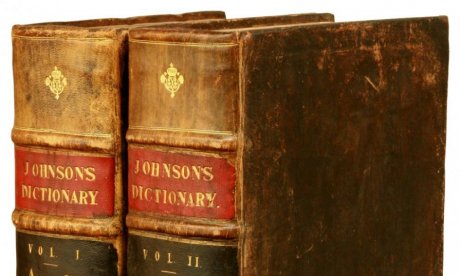The Publication of the ‘Dictionary of the English Language’ by Dr. Samuel Johnson
- 15th April 1755 -
 There are several seminal works in the English language – The Venerable Bede’s Ecclesiastical History of the English People, The Canterbury Tales by Chaucer, The Diary of Anne Frank, War and Peace by Tolstoy – and the Dictionary written by Samuel Johnson is certainly one of those.
There are several seminal works in the English language – The Venerable Bede’s Ecclesiastical History of the English People, The Canterbury Tales by Chaucer, The Diary of Anne Frank, War and Peace by Tolstoy – and the Dictionary written by Samuel Johnson is certainly one of those.
Johnson, born on September 18th 1709 in Lichfield, was not a healthy child. Baptised early in case he did not survive infancy he was scarred for life by scrofula, possibly a form of tuberculosis. He had a drip in his arm for much of his early life, was blind in one eye and also hard of hearing. His father was a bookseller and it was probably living his life surrounded by books that gave him a lifelong love of literature. Educated at Lichfield Grammar School he went on to Oxford University but had to drop out through lack of money. He despised the fact that inferior scholars to himself were able to further their education and was embarrassed by his lack of funds.
He tried his hand at teaching but could not find permanent work, possibly due to his appearance, twitches and unusual mannerisms which pupils found both off-putting and funny. Thus he drifted into a life of writing and moved to London in 1737 in order to further his career, two years after marrying Elizabeth Porter, 20 years his senior. He wrote for a number of periodicals as well as writing biographies, book reviews and poems. His poems London in 1738 and Vanity of Human Wishes were particularly well received as were his Rambler Essays. He also wrote accounts of proceedings in Parliament.
It is for his dictionary, however, that he is probably best remembered. This was commissioned by a group of London booksellers to formalise the rules governing the English language. It took him over eight years to complete and he had the help of eight researchers. Over 40,000 words are defined in detail in the book, giving quotations from a wide range of sources as well as giving the word’s etymology. Johnson sometimes twisted, re-wrote or chopped out parts of the quotation in order to convey the precise meaning he wanted to get across.
In his preface Johnson talked about ‘the energetic variations of the English language’ and the need to instill some discipline into it. He had hoped to give a definitive summary but realised that the language was always evolving and that all he could do was to record the language of his day. In a book he wrote, called The Plan, he proposed to write “a dictionary by which the pronunciation of our language may be fixed, and its attainment facilitated; by which its purity may be preserved, its use ascertained, and its duration lengthened.”
He has sometimes been criticised for putting too much of himself into the work. For example in his definition of Oats - “a grain which in England is generally given to horses, but in Scotland supports the people.” He was deeply conservative and this comes across. As Sidney Landau puts it in his book, Dictionaries: The Art and Craft of Lexicography, “Johnson’s Dictionary is not distinguished by its innovations . . . but by the skillful and original execution of techniques already established, albeit provisionally, in early modern English lexicography. What Johnson did, he did supremely well.”
After the death of his wife he became good friends with the writer James Boswell and they toured Scotland. When Johnson died on 13th December 1784 Boswell set about writing his famous account – ‘The Life of Samuel Johnson’. Johnson was buried in Westminster Abbey and his dictionary allowed knowledge to spread more easily from person to person through the use of standardised language.


